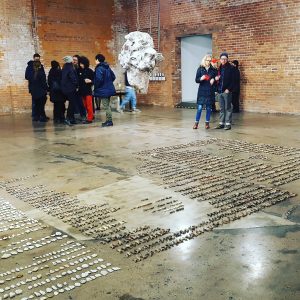An Artist Finds the Roots of Language in Natural Forms
Over the past 40 years Michele Oka Doner has been developing her own “personal hieroglyphics” shaped out of clay to illustrate how language comes from nature.

DETROIT — The exhibition Fluent in the Language of Dreams at Wasserman Projects picks up a project that Michele Oka Doner began 40 years ago. Doner is a native Floridian, but spent almost two decades in Michigan, pursuing degrees at University of Michigan and setting up an experimental studio practice. It was at the Detroit Institute of Arts (DIA) that Doner first attempted to render her notion of “personal hieroglyphics” — that is, to discover and build a language out of nature’s organic forms and found objects.
“I’ve always had a sense, from the time I saw hieroglyphics, that they were connected to the natural world, in shape and thought,” said Doner, in a phone interview with Hyperallergic. “The other idea I had was that they were language as form, instead of word. For example, the hieroglyphic for ‘red’ in ancient times was a flamingo in flight, because that’s where they saw red. It’s just beautiful how they weren’t separating living [from] nature. Over the years I have developed that thought and honed the notion that language comes from nature.”
Fluent in the Language of Dreams, installation view
Doner has titled her series Pages; the first two were shown at DIA in 1978, and now, “Pages III and IV” have made their debut at Wasserman Projects. At a glance, they read as meticulous arrangements of found objects, like rocks, bone fragments, shells, and the occasional bit of plastic, that look like indecipherable messages written on the gallery’s polished concrete floor. But closer observation reveals many of these minute forms to be exactingly built out of kiln-fired clay by Doner, who has rendered dozens of similar but individualized figures in a language ordered only by her own consciousness.
Doner’s influences are multitudinous, drawing on how language has been described in literature and religion, from ancient times to today.
“The nuance of emotion is probably only 3,000 years old,” Doner asserts. “In The Iliad, Homer writes that when the warriors looked at the battlefield, they said, ‘The Gods commanded me to do this,’ but in The Odyssey, the warriors looked at the battlefield and they wept. Julian Jaynes, in his remarkable book, The Origin of Consciousness and the Breakdown of the Bicameral Mind, asks, what happened? And, as it turns out, what happened was the development of consciousness, and feeling that came with it. So I’m interested [in] language as a living form, and how it keeps shifting.”
A detail view of Doner’s wunderkammer of elements and inspirational forms
Fluent in the Language of Dreams (Wasserman Projects) from Michele Oka Doner on Vimeo.
Doner’s “Glyph” hangs to the left. The artist describes the larger form as
“my own giant, that is speaking or grunting these words.” (image courtesy Wasserman Projects)
All this is a kind of heady underpinning to work that feels intuitive and deeply rooted in timeless elements and materials. Doner deals in clay, wax, and wood, and creates subtly sparkling elements by incorporating iron-ore dust in the infrastructural pieces of her exhibition, like a long wooden display table for a kind of wunderkammer of larger objects, and a hook from which hangs a massive iteration of one of her smaller “glyphs.” This glittery matrix seems to suggest Doner’s forms are mere microcosms of some cosmic fundament that is the real language of creation.
Fluent in the Language of Dreams, installation view
For followers of the Bible, Genesis 1:26-1:27 proposes the idea that mankind is made in God’s image, which has generally given rise to the notion that God is a guy with a beard in the sky. Perhaps a more intuitive interpretation, however, is that God is a creative spirit. Certainly, surrounded by the work of Michele Oka Doner, and listening to her speak about the evolution of language and consciousness, it occurs to me that there is something divine about looking at the potential of our world, and reaching for clay.
Fluent in the Language of Dreams continues at Wasserman Projects (3434 Russell St #502, Detroit) through May 5.
Correction: The author of The Origin of Consciousness in the Breakdown of the Bicameral Mind is Julian Jaynes, not Julian James. This has been amended.





